The suction effect of a vacuum cleaner is just a bi-product of the turbine compressor pushing air, same as the compressors on the water pumps we use in aquariums. Both are active pumps and passive vacuums.
restricting powerhead flow?
- Thread starter cmar
- Start date
You are using an out of date browser. It may not display this or other websites correctly.
You should upgrade or use an alternative browser.
You should upgrade or use an alternative browser.
No, that is entirely true.
Have you ever actually measured the amperage draw on an electric motor with a digital volt meter while the motor is put under increased strain? The amp draw and wattage used goes UP always.
I think you are confusing electric motors with pumps and also the roles that inlets and outlets play in the compressors/pumps that are powered by the electric motors.
Have you ever actually measured the amperage draw on an electric motor with a digital volt meter while the motor is put under increased strain? The amp draw and wattage used goes UP always.
I think you are confusing electric motors with pumps and also the roles that inlets and outlets play in the compressors/pumps that are powered by the electric motors.
Groan... Sorry schigara that's not actually true.
You can restrict any centrifugal pump as long as you don't block it totally. The pump wattage will ALWAYS go down, not up. The pump will last longer and run cooler. The pump will in NO WAY work harder or be negatively effected in any way by restricting the output.
You can also divert either is fine. Diverting just uses more power.
Ok! For those of you willing to learn new things, and overturn past mistaken beliefs, I took a few hours and set up a demonstration to show the principal I have been explaining. Yes, I know it goes against the common understanding but that makes no difference against the actual facts. Let me remind you that for centuries we thought the Sun rotated around the Earth. We also thought the earth was flat...
To restate it: Throttling down a centrifugal pump does not harm it. Nor does it wear out its impeller. Nor does it over heat it. Nor does it damage its bearings, chemically or otherwise. This is absolutely true as long as the flow is not completely blocked.
Onward to the demo.
Here is the simple straight forward setup. It's a magnetic drive pump. An 1100gal/hr Little Giant pump made specifically for aquarium service.
A standard schedule 80 bulkhead was used and all piping and the ball valve are 1 inch which is the same as the pump inlet and outlet.
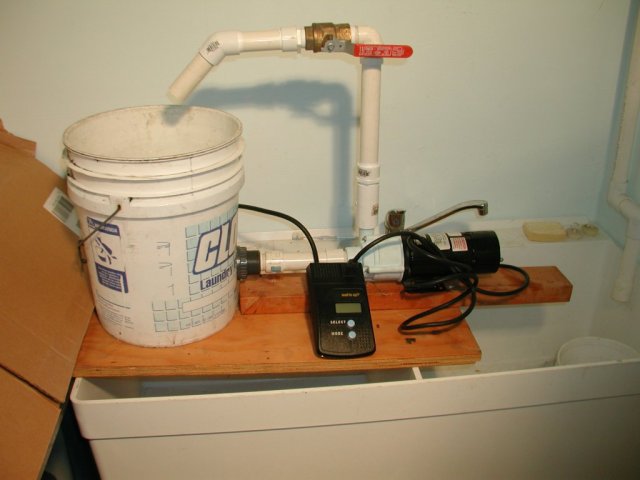
Close up of the pump.
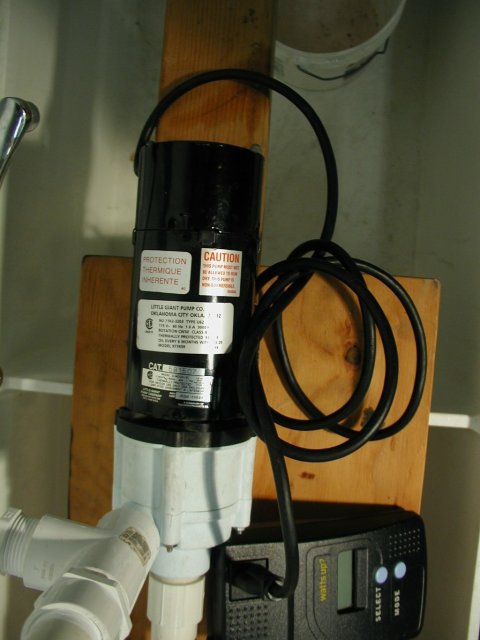
A close up of the excellent wattmeter that was used.
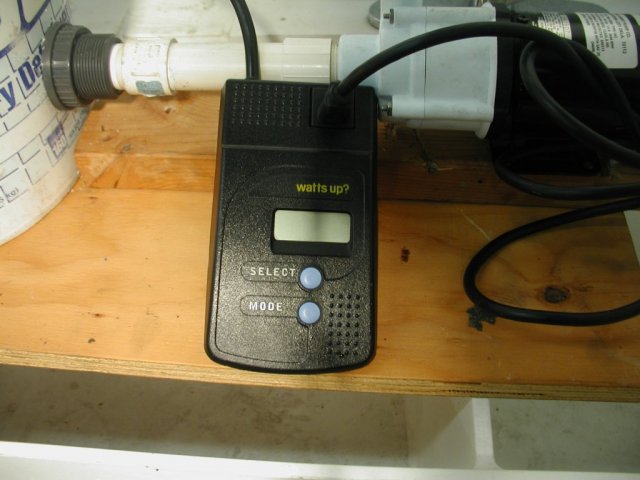
The unrestricted bulkhead fitting.
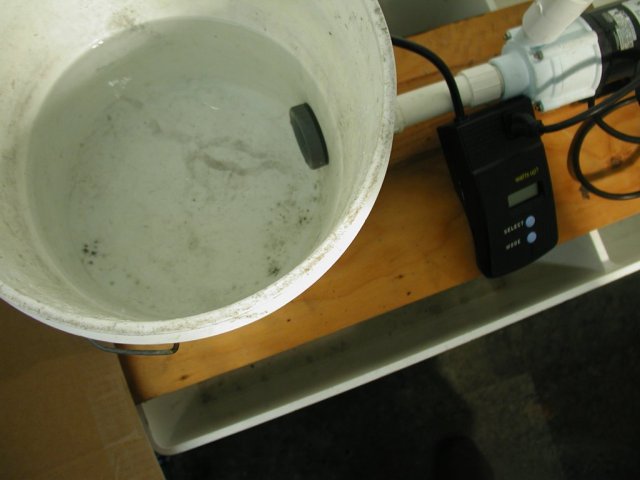
Here we go. The system running with the ball valve wide open.
The pump is consuming about 100W of power doing maximum work, which is
moving about 1100gals/hr of water. Note the solid column of water returning to the tank. 103.8W
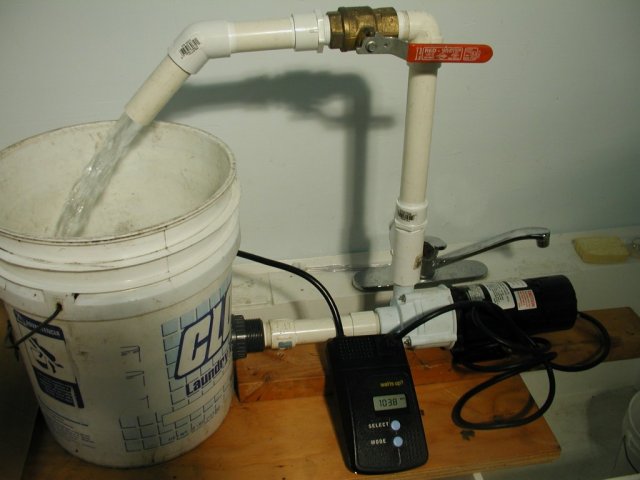
Now for some throttling. The ball valve is about half closed.
Notice the flow has dropped substantially. Notice also the power has not risen. The pump is not working harder.. It is working LESS. The power has decreased. 72.7W
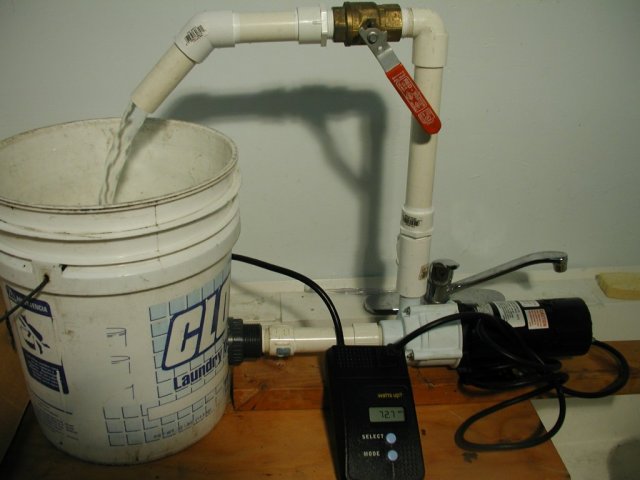
Now the valve has been closed about 25%. Power has dropped still further.
57.9W
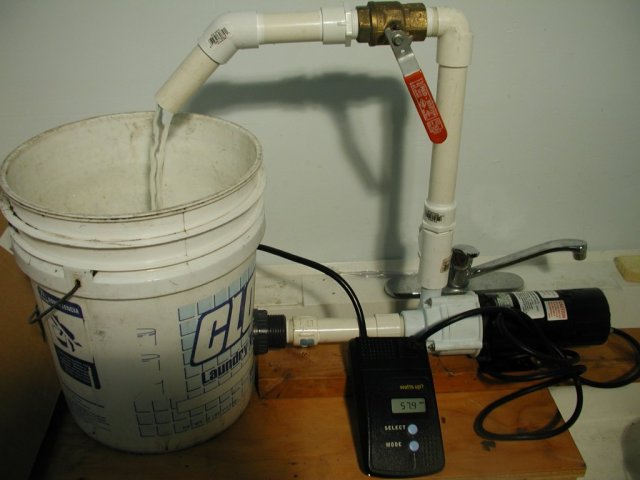
Here I have closed completely, blocked, the flow. Notice the power has dropped further yet! Of course it is not zero as there is a fan being run, bearing friction is present. Windage is occurring in the motor. There is resistance in the windings and there is some recirculation occurring in the pump head. Over time - minutes - the pump head would get warm. If there was the slightest trickle of water allowed thru the pump there would be no measurable heating as water can carry a great deal of heat away.
47.7W
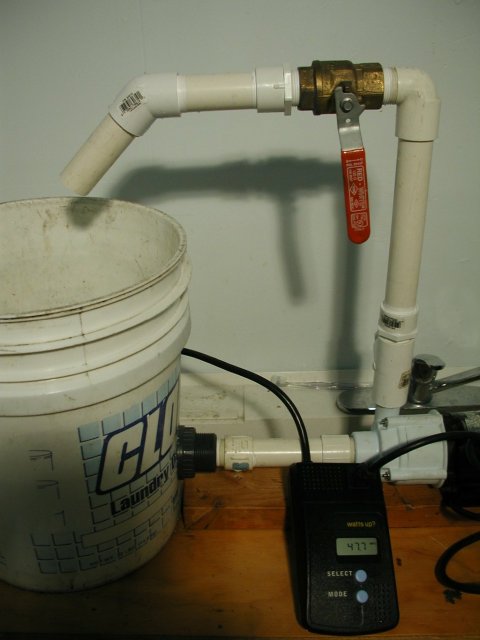
I hope this helps you shed a very common misconception.
Get the closest sized pump you can.
If it over runs your return system, you can put in a valve and throttle the flow a little. Pay less to the power company and put less carbon into our atmosphere.
Or, divert to your sump which marginally adds a little more heat to your aquarium's water and stirs your water a little more.
It's your choice, but now you can make it based on facts.








To restate it: Throttling down a centrifugal pump does not harm it. Nor does it wear out its impeller. Nor does it over heat it. Nor does it damage its bearings, chemically or otherwise. This is absolutely true as long as the flow is not completely blocked.
Onward to the demo.
Here is the simple straight forward setup. It's a magnetic drive pump. An 1100gal/hr Little Giant pump made specifically for aquarium service.
A standard schedule 80 bulkhead was used and all piping and the ball valve are 1 inch which is the same as the pump inlet and outlet.

Close up of the pump.

A close up of the excellent wattmeter that was used.

The unrestricted bulkhead fitting.

Here we go. The system running with the ball valve wide open.
The pump is consuming about 100W of power doing maximum work, which is
moving about 1100gals/hr of water. Note the solid column of water returning to the tank. 103.8W

Now for some throttling. The ball valve is about half closed.
Notice the flow has dropped substantially. Notice also the power has not risen. The pump is not working harder.. It is working LESS. The power has decreased. 72.7W

Now the valve has been closed about 25%. Power has dropped still further.
57.9W

Here I have closed completely, blocked, the flow. Notice the power has dropped further yet! Of course it is not zero as there is a fan being run, bearing friction is present. Windage is occurring in the motor. There is resistance in the windings and there is some recirculation occurring in the pump head. Over time - minutes - the pump head would get warm. If there was the slightest trickle of water allowed thru the pump there would be no measurable heating as water can carry a great deal of heat away.
47.7W

I hope this helps you shed a very common misconception.
Get the closest sized pump you can.
If it over runs your return system, you can put in a valve and throttle the flow a little. Pay less to the power company and put less carbon into our atmosphere.
Or, divert to your sump which marginally adds a little more heat to your aquarium's water and stirs your water a little more.
It's your choice, but now you can make it based on facts.








Oh, please understand I'm not someone that thinks that whatever is the generally accepted thought will be the same tomorrow. Not in the least. I'm more than willing to consider what you've set up above but I don't trust my knowledge of the mechanics enough to make a judgement on it so rely on people I trust. I'll be looking forward to what some say in response. This isn't because you're not trustworthy but I'm not one to accept anything for fact until I've seen repeatable findings by sources I find credible or are in such great numbers the experiences are persuasive on their own.
Or, divert to your sump which marginally adds a little more heat to your aquarium's water and stirs your water a little more.
It's your choice, but now you can make it based on facts.
I acknowledged the facts earlier when I did some computations myself
Wow Kcress.. Talk about dedication to proving a point 
I appreciate that you went through all of this to show us your point. It is nice to learn something new. Thanks.
But now I have to head off to work.. For some reason fiber work is at a premium this month...
I appreciate that you went through all of this to show us your point. It is nice to learn something new. Thanks.
But now I have to head off to work.. For some reason fiber work is at a premium this month...
Everything. I work for an infrastructure company and we pretty much do it all but provide an Internet connection or telephone service (we used to do the latter a long time ago). We do security (I'm lucky however and we no longer take the callsThanks cmar.
And thank you clown-lover. Fiber optics? Telecom or media?
During the summers I spend a lot of time doing small community telco upgrades as it seems like RUS is pouring lots of money into fiber upgrades in rural america. During the fall I do a lot of indoor fiber work. If its fiber we pretty much do it all. Its not a bad gig, this last summer most of my stuff was close to home but that won't be true this year. Thats why I just installed an ATO and some other stuff to hopefully make life easier for my baby sitters.


